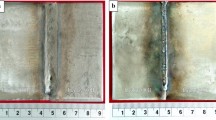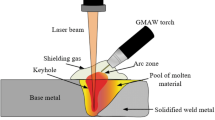Abstract
This paper utilized a flux-cored arc welding (FCAW) technique and investigated various groove configurations as well as multi-pass welding sequences to create welding specifications in the precision mechanical press industry. Experimental investigations were conducted to examine the influence of three different groove configurations of 40-mm-thick JIS SS400 structural steel welded joints on mechanical and metallurgical properties. Mechanical properties of the welded joints were evaluated by uniaxial tensile testing and Charpy V-notch (CVN) impact testing at room temperature. Simultaneously after a multi-pass welding sequence, various degrees of thermal treatments such as tempering or normalization inevitably occur in the heat-affected zone (HAZ). The unfavorable microstructures in the HAZ and reheated zones can be intentionally modified via the above procedure such that the toughness and microhardness of the HAZ improve. The experimental results revealed that of the three types of groove configurations (C1, C, and F), groove type C1 possessed the maximum yield strength (YS) and ultimate tensile strength (UTS) while groove type F possessed the highest CVN values tested at room temperature. The fundamental reason may be attributed to heat dissipation characteristics of each groove configuration and associated exertion of the multi-pass welding sequence. Microstructural and morphological features as revealed through an optical microscope also indicate a significant influential factor of these joints among the different groove configurations. Therefore, grain refinement of varying degrees can be obtained due to the variation of thermal characteristics of heat input/dissipation; thus, various mechanical and CVN impact properties can be obtained.
Similar content being viewed by others
References
Murugan S, Rai SK, Kumar PV, Jayakumar T, Raj B, Bose MSC (2001) Temperature distribution and residual stresses due to multipass welding in type 304 stainless steel and low carbon steel weld pads. Int J Pres Ves Piping 78:307–317
Kang JG, Ryu GS, Kim DC, Kang MJ, Park YW, Rhee S (2013) Optimization of arc-start performance by wire-feeding control for GMA welding. J Mech Sci Technol 27(2):501–509
Kou S (2002) Welding metallurgy. 2nd ed. A Wiley-Interscience Publication
Babu SPK, Natarajan S (2010) High temperature corrosion and characterization studies in flux cored arc welded 2.25Cr-1Mo power plant steel. JMEPEG 19:743–750
Aloraier A, Almazrouee A, Shehata T, Price JWH (2012) Role of welding parameters using the flux cored arc welding process of low alloy steels on bead geometry and mechanical properties. JMEPEG 21:540–547
Quintino L, Liskevich O, Vilarinho L, Scotti A (2013) Heat input in full penetration welds in gas metal arc welding (GMAW). Int J Adv Manuf Technol 68:2833–2840
Liao MT, Chen WJ (1999) A comparison of gas metal arc welding with flux-cored wires and solid wires using shielding gas. Int J Adv Manuf Technol 15:49–53
Myers T (2010) Cost, overall operator appeal, and weld quality must all be considered when selecting the shielding gas for a flux cored arc welding application. Weld J 80:30–33
Kumar VV, Murugan N (2011) Effect of FCAW process parameters on weld bead geometry in stainless steel cladding. JMMCE 10:827–842
Moon HS, Kim YB, Beattie RJ (2006) Multi sensor data fusion for improving performance and reliability of fully automatic welding system. Int J Adv Manuf Technol 28:286–293
Sharma V, Shahi AS (2014) Effect of groove design on mechanical and metallurgical properties of quenched and tempered low alloy abrasion resistant steel welded joints. Mater Des 53:727–736
Aloraier AS, Ibrahim RN, Ghojel J (2004) Eliminating post-weld heat treatment in repair welding by temper bead technique: role bead sequence in metallurgical changes. J Mater Process Technol 153–154:392–400
Wang J, Li Y, Liu P (2003) Effect of weld heat input on toughness and structure of HAZ of a new super-high strength steel. Bull Mater Sci 26:301–305
Frydman S, Konat L, Pekalski G (2008) Structure and hardness changes in welded joints of Hardox steels. Arch Civil Mech Eng 8(4):15–27
Mirzaei M, Jeshvaghani RA, Yazdipour A, Zangeneh-Madar K (2013) Study of welding velocity and pulse frequency on microstructure and mechanical properties of pulsed gas metal arc welded high strength low alloy steel. Mater Des 51:709–713
Meric C, Tokdemir M (1999) An investigation of the weld region of the SAE 1020 joined with metal active gas and determination of the mismatch factor. JMEPEG 8:601–605
Gharibshahiyan E, Raouf AH, Parvin N, Rahimian M (2011) The effect of microstructure on hardness and toughness of low carbon welded steel using inert gas welding. Mater Des 32:2042–2048
Kumar S, Shahi AS (2011) Effect of heat input on the microstructure and mechanical properties of gas tungsten arc welded AISI 304 stainless steel joints. Mater Des 32:3617–3623
Lee JS, Jeong SH, Lim DY, Yun JO, Kim MH (2010) Effects of welding heat and travel speed on the impact property and microstructure of FC welds. Met Mater Int 16:827–832
Lan L, Qiu C, Zhao D, Gao X, Du L (2012) Analysis of martensite–austenite constituent and its effect on toughness in submerged arc welded joint of low carbon bainitic steel. J Mater Sci 47:4732–4742
Nascimentoa MP, Voorwalda HJC, Filho JCP (2011) Fatigue strength of tungsten inert gas-repaired weld joints in airplane critical structures. J Mater Process Technol 211:1126–1135
ASTM International (2013) Standard test methods for notched bar impact testing of metallic materials (ASTM E23-12c). ASTM International, West Conshohocken
ASTM International (2011) Standard test method for Knoop and Vickers hardness of materials (ASTM E384-11). ASTM International, West Conshohocken
Eroglu M, Aksoy M, Orhan N (1999) Effect of coarse initial grain size on microstructure and mechanical properties of weld metal and HAZ of a low carbon steel. Mater Sci Eng, A 269:59–66
Dyja D, Stradomski Z, Stachura S (2005) Solidification structure of massive castings from duplex cast steel. Arch Foundry 5:79–86
Loureiro AJR (2002) Effect of heat input on plastic deformation of undermatched welds. J Mater Process Technol 128:240–249
Diaz-Fuentes M, Iza-Mendia A, Gutierrez I (2003) Analysis of different acicular ferrite microstructures in low-carbon steels by electron backscattered diffraction. Study of their toughness behavior. Metall Mater Trans A 34A:2505–2516
Svensson LE (1994) Control of microstructures and properties in steel arc welding. CRC Press, Boca Raton, FL
Chen Y, Chen S, Li L (2008) Effects of heat input on microstructure and mechanical property of Al/Ti joints by rectangular spot laser welding-brazing method. Int J Adv Manuf Technol 44:265–272
Ramakrishnan M, Muthupandi V (2012) Application of submerged arc welding technology with cold wire addition for drum shell long seam butt welds of pressure vessel components. Int J Adv Manuf Technol 65:945–956
Hyde T, Sun W (2009) Creep damage modelling of welds with heterogeneous structures. 3rd International Conference on Integrity, Reliability and Failure, Porto/Portugal 20-24
Prasad K, Dwivedi DK (2006) Some investigations on microstructure and mechanical properties of submerged arc welded HSLA steel joints. Int J Adv Manuf Technol 36:475–483
Author information
Authors and Affiliations
Corresponding author
Rights and permissions
About this article
Cite this article
Ling, KH., Fuh, YK., Wu, KL. et al. Groove configurations of a flux-cored arc welding process used in critical structures of precision mechanical presses—mechanical and metallurgical studies. Int J Adv Manuf Technol 78, 1905–1916 (2015). https://doi.org/10.1007/s00170-014-6766-7
Received:
Accepted:
Published:
Issue Date:
DOI: https://doi.org/10.1007/s00170-014-6766-7




